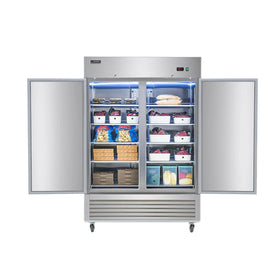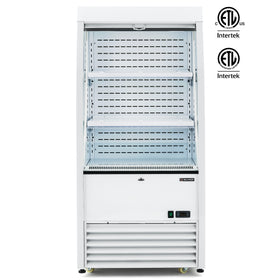Walk-in commercial refrigerators and reach-in commercial refrigerators: both are effective commercial cold-storage options for any food business, but which one is best for your business?
To help you decide, we are comparing walk-in vs reach-in refrigerators across design purpose, size, capacity, what they store best, performance, energy, and which businesses they suit.
We will keep it clear and business-focused, so you can arrive at a clear decision on which is better for your shop/business.

Walk-in vs Reach-in Refrigerators: Quick Summary
- Reach-in commercial refrigerators: The upright, cabinet-style commercial fridges that have a door. Compared to the walk-in refrigerators, they are better for back-of-the-kitchen use, for storing frequently accessed items, and for small footprint operations. They are also more affordable (lower upfront cost)
- Walk-in commercial refrigerators: basically a small chilled room you can enter (walk-in). Compared to reach-in refrigerators, they are better for bulk storage and operations that need large, organized inventories.
However, they can be very complex to install, and are more expensive (higher upfront costs).
Walk-in vs Reach-in Refrigerators: Key Differences
Walk-in refrigerators are fundamentally different from reach-in refrigerators, and the differences in the key features they offer make each of these commercial refrigerators suitable for different kinds of businesses.
1. Design and Purpose
Reach-in refrigerators are designed for quick, convenient, and easy accessibility to the products on the shelves.
- Reach-in display refrigerators, also known as glass door refrigerators, are ideal for front-of-shop use to display items to customers and encourage purchasing
- Reach-in solid door refrigerators are designed for commercial kitchen use. They keep the ingredients and food items cool while making them accessible to chefs and other kitchen staff.
Overall, a reach-in refrigerator is perfect if you are looking for a working fridge for prepping or for frontline use.
Walk-in refrigerators are specifically designed to store large volumes and bulk purchases. In addition to bulk storage, they keep the items organized and visible so staff can easily walk in, locate, and up specific items without delays.
Overall, a walk-in refrigerator is perfect if you buy in bulk, ship in pallets, or if your business requires bulk storage in general.

2. Size and Capacity
Reach-in refrigerators vary in size, but generally offer less capacity compared to walk-in refrigerators. The typical commercial width for a reach-in refrigerator would be about 27 to 90 inches for 1-3 door models, while capacity ranges from a few cubic feet to a few hundred cubic feet (for tall models).
Walk-in refrigerators, on the other hand, offer significantly more storage capacity. A walk-in can be effectively any size, from a small locker walk-in (a few hundred cubic feet) to a large room offering multi-thousand cubic feet capacity.
So, assess your storage needs, both present and future: a reach-in is sufficient if you need a small footprint and moderate storage capacity.
If you require space for bulk inventory, then a walk-in is clearly the better option.
3. Consider the Kinds of Products You Store
Reach-in refrigerators are designed for storing items like ready-to-grab ingredients, daily prep items, drinks, and deli cases that need to be accessed many times per hour, either by customers or staff.
Walk-in refrigerators are for bulk proteins, kegs, crates, heavy pans, large tubs of sauce, and other kinds of inventory that might only be accessed on a weekly or bi-weekly basis.
- For a shop, consider a reach-in display refrigerator
- For a commercial kitchen, consider a reach-in solid door refrigerator
- For a warehouse, supermarket storage space, or food retail business requiring cold storage, go for a walk-in refrigerator.

4. Energy Use and Operating Costs
It may appear like walk-in refrigerators consume much more electricity than reach-in models, but that is not necessarily the case: it all depends on usage patterns and the scale of the business.
- A single reach refrigerator, especially if it is ETL certified for energy efficiency, will use less energy than a large walk-in refrigerator.
- However, if you are using several reach-in refrigerators, the total amount of energy consumed may meet and even exceed a properly used walk-in refrigerator.
Also, walk-in refrigerators do not always consume a lot of energy: if it is properly insulated and used at high capacity (centralized compressor, less surface area per stored unit), it can actually be as energy efficient, on a per cubic foot basis, as any reach-in refrigerator.
However, it must be said that energy efficiency is much harder to attain with a walk-in refrigerator: absolute energy draw is higher, and if it is half-empty (or the doors are not properly sealed), the standby losses are much higher.
5. Installation, Maintenance, and Lifetime Cost
Reach-in refrigerators are easier to install, maintain, and use over time. Installation is plug and play (most of the time), they are a lot easier to clean and maintain, and can be easier to use because they are ADA/commercial kitchen friendly.
Walk-in refrigerators, on the other hand, are more expensive to install (considering the cost of the panels, floor, labor, electricity installation, and sometimes permits). Installing a walk-in refrigerator sometimes requires complex infrastructural changes like site prep (drain, floor strength, etc).
Maintaining and repairing a walk-in refrigerator is also much more complex, as it requires dealing with larger compressors, door seals, defrost systems, etc.
Walk-in vs Reach-in Refrigerators: Key Differences
| Feature / Aspect | Reach-In Refrigerator | Walk-In Refrigerator |
| Purpose / Design | Quick, convenient, and easy accessibility | Designed to store large volumes and bulk purchases |
| Capacity | Smaller storage capacity | Significantly larger storage capacity |
| Typical Stored Items | Ready-to-grab ingredients, daily prep items, drinks | Bulk proteins, kegs, crates, heavy pans, large tubs of sauce, weekly/bi-weekly inventory |
| Ease of Installation and Maintenance | Easier to install, maintain, and use over time | More expensive and complex to install (panels, floor, labor, electricity, permits) |
Walk-in vs Reach-in Refrigerators: Making Your Final Decision
1. Consider the Volume of Items You Buy/Store
Choose a reach-in refrigerator if you buy in small daily orders
Choose a walk-in refrigerator if you buy in bulk, ship pallets, or intend to store large volumes of items.
2. Frequency of Use
How frequently will the items be accessed?
- If the items will be pulled many times per hour (prep line), go for a reach-in refrigerator.
- For back-of-the-house use where items will not be accessed frequently, choose a walk-in refrigerator
3. Floor Space and Layout
How much room does your business have, and how much of it can you reasonably dedicate to storage space?
- If you are struggling with space, a reach-in refrigerator is the more space-efficient option.
- To build a walk-in refrigerator, you need a room (or at least some outside space).
4. Costs: Both Upfront and Operating Costs
- A reach-in refrigerator is the more affordable option, both in terms of upfront costs and operating costs.
- A walk-in unit is more expensive upfront, especially considering installation costs, but if fully utilized, properly insulated, and well-maintained, it can be cheaper in the long term.
The key is to run the numbers. Taking into account local electricity costs in your area, do an estimate for purchase+installation+permit costs vs projected kWh and maintenance.
5. Future Growth Considerations
How quickly can you reasonably expect your business to grow? A walk-in refrigerator, in spite of its higher initial cost, is the smarter option if you expect your business (and therefore your storage needs) to grow rapidly in a short time.
If you are uncertain about future growth, a walk-in refrigerator is the more financially conservative option in the short term.

Walk-in vs Reach-in Commercial Refrigerators: Final Recommendations for Different Businesses
- Tiny café/kiosk: 1–2 reach-ins (consider an under-counter refrigerator model or single/double-door shop fridge model). These are cheaper and more space-efficient.
- A restaurant with medium demand: A small walk-in refrigerator for bulk + 1–2 reach-ins at the line for speed (best practice)
- For a supermarket for wholesale, consider large walk-in(s) for back storage, plus display reach-ins for customer access.
A reach-in refrigerator is ideal for small cafés, bars, convenience stores, food trucks, bakeries, small delis, and any business with limited floor space and moderate cold-storage needs.










